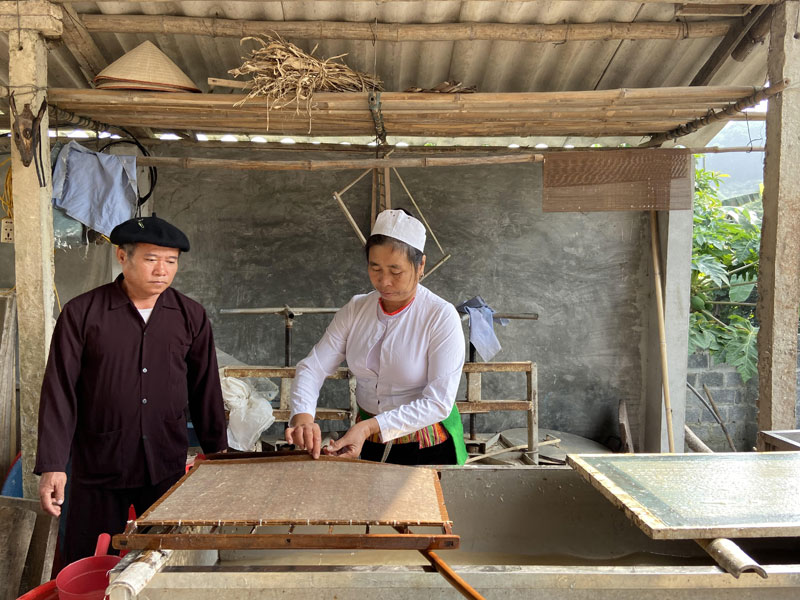


 The artisan making Do paper in Suoi Co village, Hop Hoa
commune - now Cao Son commune (Luong Son) is performing the process of making
paper on the mold.
The artisan making Do paper in Suoi Co village, Hop Hoa
commune - now Cao Son commune (Luong Son) is performing the process of making
paper on the mold.
Do paper is very special paper, so the production process is not simple. To make paper, it is necessary to go through 35 stages. It takes half a month from taking materials, soaking and making products. The type of trees used most to make paper are Do (Aquilaria crassna) and Duong (Broussonetia papyrifera) (called Rang tree by Muong ethnic people).
The equipment for making Do paper is also gradually improved to reduce the time and the stages of completion. The main tools are cloth molds, available in various sizes (30 x 40 cm, 60 x 80 cm, 60 x 120 cm), cooking pots and machines for stirring materials, tanks for soaking margins and for lifting up the paper pulp with a crowbar…
After being taken home, the leaves and branches of the broussonetia papyrifera are removed, the bark is taken to be boiled and soaked with lime water to make it puree, then it is put in the stirrer into a puree, filter to get the pure water (also known as the margin), the margin is soaked in the tank and the paper is lifted up with a crowbar. This stage is usually undertaken by Muong women. The loose paper pulp is poured on the mold, coated very thin like the coated rolls, then it is peeled off. Each stack of paper is pressed and dried. Every 10 kg of fresh bark or 4 kg of dried raw bark will produce about 120 sheets of paper. The final step is to put the sheets in layers, depending on the type of paper to use a piece of cork to pulley in the size of 10 x 20 cm or 20 x 30 cm.
From the skillful hands of the artisans, according to their own secrets, Do paper is thin but it is tough and durable than the paper made in the industrial process. It has the faintly scent of forest trees. If it is stored in a dry place, the paper can be left for several decades. Therefore, now it is not only a material for painting, writing, under the creativity of the artisans Do paper has become a product for tourism development in many parts of the country.
In addition to the Northern provinces, Do paper of Muong ethnic people in Suoi Co are also trusted to use by the travel and tourism companies in the Central and Southern regions such as Hue, Hoi An, Da Nang, Lam Dong ... Currently, the artisan Nguyen Van Chuc continues to search for the output for the product with the hope to contribute efforts to the craft villages throughout the country to help Do paper gradually regain its position in the traditional culture.